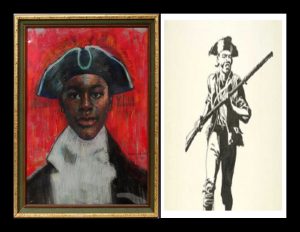
Tracing the history of blacks in comic books is much like tracing blacks in the American history offered in school books; you can find blacks appearing sporadically or when directly contributing to the particular subject, but otherwise are not the focus, or regulated to “support characters” or sidekicks. For example, Crispus Attucks is without a doubt one of the most familiar Blacks associated with the Revolutionary War, but little is said about Prince Estabrook, who was wounded at the battle of Lexington and Concord, or Peter Salem and Salem Poor, who both earned special distinction for bravery in the battle of Bunker Hill. The history of blacks appearing in comics and the black creators working in comic books is much deeper than what appears on the surface or what is offered by what is considered to be the “mainstream”, and when and properly researched, is more apparent than noticed. Black creators, artists, and publishing companies have existed since the beginning of comic book history and the images and depictions have not all been the stereotypical, degrading characters that have been presented by some major comic publishers; characters such as Whitewash Jones who first appear in the Young Allies comic series from the 40’s. Indeed, some of the earlier publishers portrayed black characters and stories with as much dignity and class as any of their other comic book properties, and were not afraid to take a chance and publish stories featuring blacks in non-stereotypical and leading roles. Many of these first publishing companies were small and eventually either closed or were purchased by major companies but their contributions are considered large in the comic book industry. Little did the creators of the original comic book know, but with an attitude akin to, “whatever you can do I can do better”, Black artist and creators began to matriculate from the comic strips that were so popular during this time period, into this new medium which offered to allow the creator a bigger format and a broader audience. and began to master this art form that would draw in a new and more diverse cast of readers. In a 40 year period; starting in the 1940’s and cresting into the 1990’s; blacks not only would continue to grow with the evolution of comics, but set marks which would later lead to black creators and even black publishers and comic book shops to carve out a niche of its own. The strength and creativity of black artist and writers, as well as black characters, may have been slow to take hold in what is and has been called “mainstream” comics, but would be able to springboard from one bold move from a black publishing company, to the beginning of a black movement in comics that launched what was dubbed the “Black Age” by its founder, that helped carry blacks comics into the new millennium. When Action Comics #1 ushered in the “Age of Heroes” in 1938, it opened the door for more than just Superman to fly in.
The Forties and Fifties: The Foundation
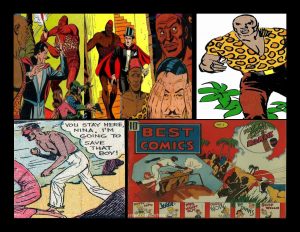
When Dell publishing put together its collection of strips in book form, it opened the door to a whole new way of displaying the cartoons that newspaper readers had come to love. Black representation in the comic strip industry was strong and visible, with Black artist appearing in black-owned publications across the country. Even the first black character to appear in the comic strips, and would later appear in comics had already in occurred in 1934 with the character, Lothar in Mandrake the Magician. The country itself was in the grips of war, and this new medium proved popular with the soldiers, who made up 30% of it’s readership. The popular characters initially were Superheroes, and companies formed to take advantage of this new and burgeoning genre. One of those companies, Better Comics, in 1939 published their collection of comic book stories in their comic entitled Best Comics. Inside the comic as advertised on the cover was the comic strip named Adventures of the Red Mask, which chronicled the adventures of the title character. What would initially stun readers that on the cover the Red Mask was actually Black, and punching a white man! The story goes that a yacht full of Americans crash off the coast of Africa and two of the survivors get lost in the jungle. The two survivors are captured by a “savage” group of natives, but are saved by a mysterious (black) man wearing a Red Mask. As it turns out, the mystery man is the rightful ruler of the land, and has had his kingdom overrun. He is now battling the hostile forces as The Red Mask. The issue two of the comic featured a white man in a red mask on the cover, but the person on in the interior is black. The comic lasted 4 issues and was not seen again.
As the format and overall look of the comics became more refined, the interior art also became more masterful. The popularity of the superheroes began to wane, at least that of the male superheroes. with not just the soldiers overseas, but also with the comic book consumers here in the states, which consisted primarily of men. The popularity of what was referred to as “Good Girl Art”, which was cover illustration of women dressed in tight skimpy outfits which were designed to stimulate began to take over. One of the best at not only drawing the good girl art style, but considered a master at drawing the female form, was Black penciller Matt Baker. Baker worked primarily as a freelancer, doing art for some of the largest publishing houses of that time.
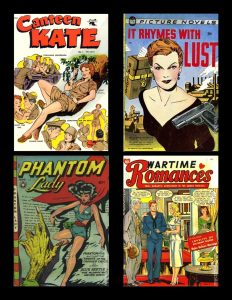
He is credited with having over 1000 comic pages and over 200 covers during his short career, Baker drew women from all walks of life. His most notable works are Phantom Lady(1947-49), Canteen Kate (1952), Wartime Romances 1951-52, and It Rhymes With Lust (1950), which is considered the first graphic novel. Baker died at the age of 37 from heart complications.
With the popularity of comics becoming bigger and bigger, stories featuring historical figures also grew in popularity along with the other genres. These comics also included black figures and in 1947 Negro Heroes #1 was published by Parent Magazine Institute featuring Booker T. Washington on the cover. A subsequent issue was published in 1948, featuring Jackie Robinson on the cover. 1947 also saw another first spearheaded by noted journalist Orrin C. Evans, considered the first Black journalist to cover general news assignments for a white mainstream newspaper. Evans wrote about segregation in the military for the newspaper, and was a big proponent of racial equality. Evans and his brother , George J. Evans Jr. and a collection of other black writers and artist went on to create the first fiction comic anthology featuring and all black cast. The book would also be celebrated for not only being written and drawn by all black creators, but in order to publish the book, Orrin founded the first black owned publishing company. The company, named All Negro Comics Inc. , was able to publish only one issue before the they were shut out of purchasing the needed materials to produce another comic. The first issue, aptly entitled, All Negro Comics, featured a variety of stories that covered several genres. The 48 page book had stories featuring characters such as Ace Harlem, a black detective, and Lion Man, who is an African warrior. It also contained funny stories and even one set in a magical world with fairies. With the positive reception received by the Negro Heroes #2 issue, Jackie Robinson became the first Black since the Red Mask to star in his own comic series with the release of Jackie Robinson, Baseball Hero, which was published in 1950 by Fawcett. The comic series ran for 6 issues. In 1954 the comic company Atlas Comics, who would become the predecessor to Marvel Comics, published its comic omnibus entitled, Jungle Tales. The comic features stories by the black character, Waku, Prince of the Bantu, whom some credited as the first black character in superhero comics, predating the Black Panther by 12 years. We see that actually he would fall behind the Red Mask of Best Comics, and Lion-Man of All Negro Comics. Waku appeared in 7 issues of the Jungle Tales series.
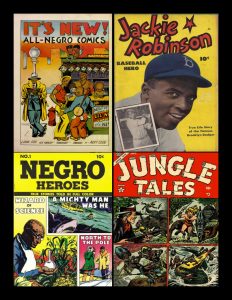
With the wane of the superhero genre, another genre that became more and more popular was the romance genre, and Blacks were just as well represented in those stories, as well as helping in the creation of them. Fawcett, once again, took the lead and hired on artist Alvin Hollingsworth; who was the first black artist they had ever hired; to draw a new romance series for them featuring Blacks in stories of their own . The series was titled Negro Romance and ran for 3 issues in 1950, with a fourth issue published in 1955 by Charlton Comics, which was a reprint of issue #2. The images of blacks portrayed in the books were no different than those of their white counterparts, and the stories were not written any different to accommodate the black images.
In the 50’s an entity was created due to what was perceived as the alleged harm comics had on the youth of the day. To combat this, the Comic Code Authority was created to police the comics to ensure their compliance to standards of morals and decency. The CCA, in one of its early act of censure, and an example of the attitude mainstream comics had toward blacks, the story “Judgement Day” appeared in Weird Fantasy #18 published by EC comics. The story features a black astronaut, and was published before the CCA took effect, When the story was sought to be republished in 1956 in the comic Incredible Science Fiction #33 the CCA forced the publisher to change the astronaut’s skin color to white. EC had published other books featuring blacks, including Two-Fisted Tales #30, which featured the first story of blacks fighting at War. The story, entitled “Bunker” featured a fictional all black infantry unit.
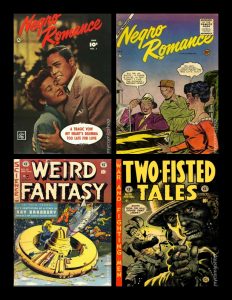
The Sixties and Seventies: The Underground
With the strength of the CCA controlling comic book content, a definite separation was formed between the comic companies, and those who were now considered to be mainstream began to dominate the industry, and non-superhero stories were more popular. Two of the most popular genres were Westerns and comics based on Television shows, and in 1965 comic publisher Dell Comics published a western series whose main character was black. The series, entitled Lobo, only managed 2 issues from 1965-1966 before being cancelled, with retailers reportedly returning unopened copies to the printer. The following year, publisher Gold Key published a series of 6 issues based on the TV series I Spy, and in doing so gave us the first black TV character to be featured in a comic. The character is based off of Bill Cosby’s character in the show, and Bill and actor Robert Culp are featured on the cover of all 6 issues.
The non-fictional, historical portrayal of Blacks in comics would continue during this period. One person in particular, Bertram Fitzgerald, and accountant with the New York State Department of Taxation and Finance, saw the lack of Black History in school books during this time, and came upon the idea of comic-style books to display the historical blacks that inspired him as a youth. He shopped his idea around to different publishing companies, but couldn’t find any who were interested. To that effect, Bertram decided to start his own company, and Fitzgerald Publishing was born. The company published its first volume in 1966, chronicling the life of Haitian hero Toussaint L’Overture. The company published 16 volumes with the last one published in 1972. Initially, Fitzgerald relied on the specialized market that was geared toward Black consumers. Finding it hard to get paid using this venue, Fitzgerald negotiated a deal with business giant Coca-Cola Company in 1967 for them to pay for the printing cost in return for prime ad space in the comic, and as part of the marketing plan, Coke would purchase and distribute magazines for free to in Schools and libraries. By 1970 when the Coca-Cola deal was ending, Fitzgerald had already negotiated similar deals with other major companies such as AT&T, McDonald’s Columbia Pictures, and Avon. Issue #2, a story featuring Harriet Tubman, is the first comic to feature a story with a non-fictional black female lead.
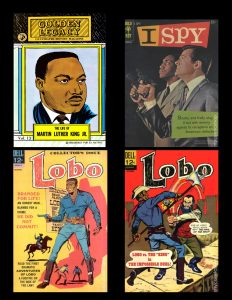
Fitzgerald publishing is also credited with having the first black women working in comics. Joan Bacchus both wrote and did art, and Linda Cade wrote issues of the Golden Legacy series. Besides providing black women an opportunity to show their skills in the comic industry, Fitzgerald was known to hire unknown, unheard of, black artist and writers, to give them an opportunity to break into the business, as well.
With the CCA acting as watchdog over comics, comic creators who refused to be limited in the content they produced and published started publishing their books without the approval of the CCA. These comics became known as “Underground Coimx” with the “x” representing much of the content in the books. The books of this period featured drug use and sex, and often books featuring parodies of popular topics of the day as well as parodies of stereotypical black characters. Also during this period was the emergence of the “direct market”, which allowed retailers to choose comics that they wished to order for their shops with the agreement that they purchase the books outright. This market created a boom in comics and allowed for new publishing companies to operate.
Up to this point, it should be noted that every single fictional Black hero that had been introduced in comics thus far had been of African descent. It seemed as though the comic creators did not see anything heroic about African Americans, and although maybe unrelated, as the Civil Rights period ended in the late 60’s and integration began to take place wide spread, the mainstream companies began to introduce more African-American characters, and although Marvel comics had introduced Black characters in the 60’s; the African chieftain, The Black Panther, and the African American sidekick to Captain America, The Falcon; respectively in 1966 and 1969; it would be 1972 when it would introduce it’s first Black fictional hero to have his own series. While this is certainly a distinction for the character, company and comic, (Luke Cage, Hero for Hire 1972), Luke Cage actually ranks 5th among appearances of Black fictional heroes who debut in their own series. It has already been shown that the Red Mask made his first appearance in 1939, and Lobo starred in his own series in 1965, but in 1970 Larry Fuller, one of only two recognized black creators during the underground period, introduced his character Ebon in the 1970 comic, Ebon #1 “A Hero is Born”, followed by Leader Comics Group and their character Blackman whose comic, Blackman Soul Wonder of the World #1 you have the second and third appearances of black heroes. Unlike Luke Cage or some of the other characters who were appearing during this time period which were modeled after the stereotypes found in the Blaxploitation films, Blackman was created by artist Tom Floyd to provide a positive role model for black youth, while Ebon was created by Larry Fuller, who had a lifetime love affair with comics, to fight against injustice. Larry Fuller is also credited to be the first black creator to both write and draw his comic.
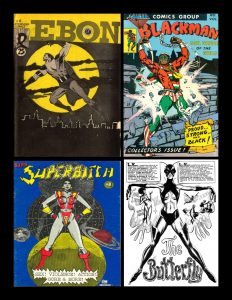
Also in 1971, we witness the first black super heroine making her debut. Marian Michael , aka, The Butterfly, debuts in issue #1 of Hell Rider magazine. The book only lasted two issue and contained Butterfly stories in each, but was sadly cancelled before an origin story was printed. Marian was a lounge singer in Las Vegas who fought crime after hours. He villains consisted of racist secret organizations and drug lords.
Comic parodies were popular in the underground, along with science fiction, horror, westerns, and mystery stories. In 1972 the second recognized black creator of the underground period, Richard “Gras” Green, released his underground comic Super Soul Comix, which was in the same style of the Blaxploitation films, but would not be his only contribution to the comics of this period. Also in 1972 publisher Charlton comics made an industry first move that set a precedent in comics. Charlton published Midnight Tales #1 which was not only created by Wayne Howard, but the comic gives Wayne Howard the credit on the cover for being its creator. This was the first time ever a comic credited the creator on the cover. When interviewed, the editor is quoted as saying he granted the created by credit because as far as Wayne was concerned, “it was hiss idea, his concept, his everything”. Indeed Howard drew every cover and every story and even wrote a few. The series ended in 1976, and Howard went on to do art for various companies, earning the reputation of being one of the most prolific black artist in the horror genre.
During this time, Dell publishing once again came with a first with the introduction of their comic, Friday Foster, capitalized on the the popularity of the character, who is not just the first black non fictional lead in comics, but in comic strips as well. And while movies based on comic book characters are a big thing in 2018, this comic has the distinction of having a movie based on it’s character. In 1975 Pam Grier starred in her last Blaxploitation film which was loosely based on the comic and comic strip.
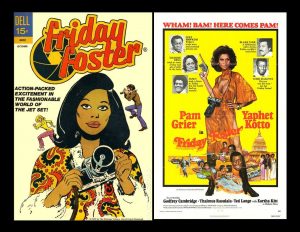
Fitzgerald Publishing was still churning out comics based on historical figures, which they published until 1976, and followed up with the comic title, Fast Willie Jackson, which was a black version of the popular Archie Comic. In 1975 Spire Christian Comics published the biographical comic, Up From Harlem, which told the story of Tom Skinner and his rise from member of the Harlem Lords gang in New York, to finding God and becoming a christian and straightening out his life. The comic is meant to steer kids away from gangs and to seek God for their problems.
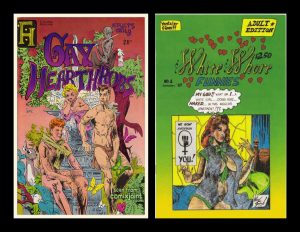
On the flipside, Larry Fuller, along with his friend Ray Horne, reemerged onto the underground scene, this time with their publishing company Ful-Horne Productions and making their mark in the pornographic/adult only genre. Their comic, White Whore Funnies, was published in 1975 and was the first of its kind. The comic lampooned and parodied inter-racial relationships. The duo followed that book up with the release of, Gayhearthrobs, in 1976. Gayhearthrobs holds the distinction of being the first homosexually themed comic in history. One of the most interesting adult themed comics from that period belongs to black creator Ira Harmon. In 1977 Harmon created the comic, Super Bitch, which told the story of Freda Foxx, who uses her super powers (namely her ability to make her boobs get bigger and her radioactive vagina) to save some astronauts who have crashed landed and been captured.
Below is a list of the accomplishments achieved by Black creators, companies, and characters, between 1934 and 1978.
1934- King Features Syndicate- Mandrake The Magician– the first appearance of a black “super” hero; Lothar
1939– Better Comics- Best Comics (4 issues)- The Red Mask character that appears in the comic is credited as being the very first Black costumed hero even though he appears white on the cover starting with the second issue
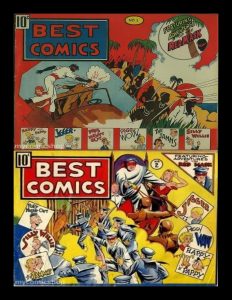
1947-1949– Matt Baker is hired by Fox Feature Syndicate to draw their Phantom Lady comic which ran for 10 issues, making him the first black artist to work in comics. Baker would go on to be hired by St John Publications and draw other comics between 1950-1952, including the comic that is considered the first graphic novel
1947- Orrin C. Evans starts the first Black Publishing company; All Negro Comics Inc. and publishes, All Negro Comics, the first Black comic to be written, drawn, and star an all-black cast.
1947;1948– Parent Magazine Institute- Negro Heroes (2 issues)- one of the first comics to feature Blacks in a non-stereotypical, positive manner
1950– Fawcett Comics hires Alvin Hollingsworth; the first black artist to work for their company; to draw the three issue series Negro Romance. The cast was entirely black and the comics resembled the style of romance comic in that time period. Issue #2 was reprinted by Charlton Comics in 1955
1950– Fawcett Comics publishes comic about Baseball player Jackie Robinson that ran for 6 issues. The comic is the first to feature a non-fictional black male character
1952– EC comics publishes story Judgement Day, which featured a black astronaut, but was later forced by the Comics Code Authority to change the character to white when they tried to reprint the story in 1956
1954- 1955– Atlas Comics, Jungle Tales, credited with first appearance of black superhero in mainstream comics, Waku, Prince of the Bantu
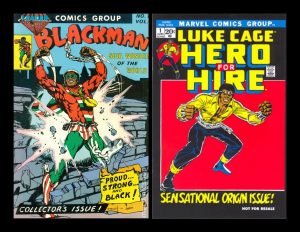
1965;1966– Dell Comics- Lobo (2 issues)- credited as first comic to feature a fictional black male lead
1966– Gold Key publishes comic from TV series, I Spy. The comic runs for 6 issues and is the first to feature a black television star.
1968– Bertram Fitzgerald starts the Fitzgerald Publishing Company and begins publishing his, Golden Legacy, comic. Fitzgerald would broker distribution deals with major corporations and is responsible for hiring the first black women to work in comics. Golden Legacy ran for 16 issues.
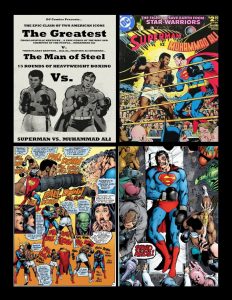
1970– Spearhead Productions- Ebon #1: A Hero is Born 1970- Larry Fuller through his Spearhead Productions company, publishes the first black independent comic character
1971– Leader Comics Group- Blackman 1971- 2nd Black hero who appeared in his own comic before Luke Cage
1972-1976– Charlton Comics- Midnight Tales (16 issues)- first comic to credit creator on the cover
1977– California Comics- SuperBitch 1977- first black fictional female to be featured in her own comic
1978– DC comics publishes it mega-hit Superman vs Muhammad Ali; Superman has to fight as a regular person and gets his butt whipped
